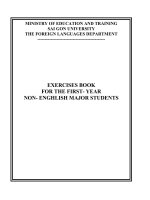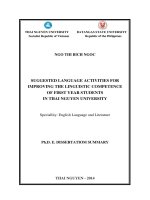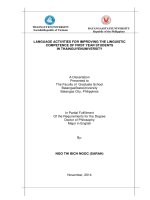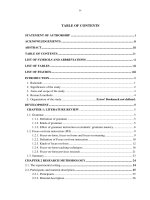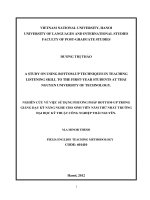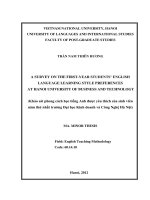Improving the first year students’ grammar through focus-on-form instruction at university of economic and technical industries
Bạn đang xem bản rút gọn của tài liệu. Xem và tải ngay bản đầy đủ của tài liệu tại đây (1.86 MB, 13 trang )
Improving the first year students’ grammar
through focus-on-form instruction at university
of economic and technical industries
Phạm Thu Yến
Trường Đại học Ngoại Ngữ
Luận văn ThS. Chuyên ngành: English Methodology; Mã Số: 60 14 10
Người hướng dẫn: Khoa Anh Việt, M.A
Năm bảo vệ: 2010
Abstract: The study was carried to assess whether focus-on-form instruction (FFI) can help develop the
first-year students’ grammar mastery at University of Economic and Technical Industries (UNETI). Total
of 26 repeat students at college level in a retake exam class at UNETI were randomly selected to be
participants, who were divided into two groups including experimental group and control group in 10
lessons, each of which lasted two hours with fifteen-minute break.The data collection instruments used in
the study were tests, questionnaire and interview. Initially, two first interview questions were used to
elicit information to design questionnaire and identify target structure. Similarly, two groups took a
pretest in the first class meeting and a posttest of the same content in the fourth lesson. The target
structure consisting of present simple and present continuous were taught in four first lessons. Compared
with the control group with no FFI, the learning gains from pre-to post tests indicated that focus-on-form
instruction helped improve students of the experimental group dramatically. In the last class meeting – the
tenth lesson, questionnaire and interview administered after the tests provided necessary information
about students’ background, difficulties and attitudes toward to focus-on-form instruction. Both
questionnaire and interview show students’ positive response to focus on form instruction though some
students are unconfident to take part in communication.Generally, quantitative data (from questionnaire
and interview) and qualitative data (from interview) support each other to show that focus-on-form
instruction helps to improve the first-year students’ grammar significantly. Additionally, students showed
their interest and agreement with focus-on-form application despite their previous habit of receiving rules
and lack of confidence in communication and figuring out rules.Based on the findings, the thesis suggests
some tips such as appropriate classroom input, non-stressed activities for eliciting grammatical rules and
helping students to take notes of basic knowledge, which enable students to overcome their unfamiliarity
when following FFI.
Keywords: Ngữ pháp; Giao tiếp; Tiếng Anh; Phương pháp dạy học.
Content:
iv
TABLE OF CONTENTS
STATEMENT OF AUTHORSHIP i
ACKNOWLEDGEMENTS ii
ABSTRACT iii
TABLE OF CONTENTS iv
LIST OF SYMBOLS AND ABBREVIATIONS vi
LIST OF TABLES vii
LIST OF FIGURES viii
INTRODUCTION 1
1. Rationale 1
2. Significance of the study 2
3. Aims and scope of the study 3
4. Research methods 4
5. Organization of the study Error! Bookmark not defined.
DEVELOPMENT 5
CHAPTER 1: LITERATURE REVIEW 5
1.1. Grammar 5
1.1.1. Definition of grammar 5
1.1.2. Kinds of grammar 5
1.1.3. Effect of grammar instruction on students’ grammar mastery 6
1.2. Focus-on-form instruction (FFI) 9
1.2.1. Focus-on-form, focus on forms and focus on meaning 9
1.2.2. Definition of Focus-on-form instruction 10
1.2.3. Kinds of focus-on-form 12
1.2.4. Focus-on-form teaching techniques 16
1.2.5. Focus-on-form previous research 21
1.3. Summary 23
CHAPTER 2 RESEARCH METHODOLOGY 24
2.1. The experimental setting 24
v
2.2. Participants and material description. 25
2.2.1. Participants 25
2.2.2. Material description 26
2.3. Research questions and hypotheses 29
2.4. Target structure 29
2.5. Research design: experimental research 31
2.6. Research procedure 32
2. 7. Data collection instruments 36
2.7.1. Questionnaire 36
2.7.2. Pre-test and post-test 38
2.7.3. Interview 48
2.8. Data collection procedure 49
2.9. Summary 51
CHAPTER 3. RESULTS AND DISCUSSION 52
3.1. Statistical analysis 52
3.2. Results 52
3.2.1. Factors relating focus-on-form instruction to develop students’ grammar 52
3.2.2. Improving students’ grammar through focus-on-form instruction 61
3.2.3. Applying focus-on-form instruction to improve UNETI students’ grammar 72
3.3. Discussion 76
3.4. Summary 79
CONCLUSION 80
1. Review of the study 80
2. Findings 80
3. Pedagogical implications 81
4. Further research 82
BIBLIOGRAPHY 83
APPENDIX 1: PRETEST I
APPENDIX 2: POSTTEST II
APPENDIX 3: PHIẾU KHẢO SÁT III
APPENDIX 4: SURVEY QUESTIONNAIRE V
APPENDIX 5: CÂU HỎI PHỎNG VẤN VII
APPENDIX 6: INTERVIEW VIII
vi
APPENDIX 7: STUDENTS’ RAW SCORES IN THE PRETEST - POSTTEST IX
LIST OF SYMBOLS AND ABBREVIATIONS
CO Control group
CR Consciousness raising task
EFL English as a Foreign Language
EA Error analysis task
EX Experimental group
FFI Focus-on-form instruction
GT Tense gap-fill task
IELTS International English Language Testing System
L1 Native Language
L2 Second Language; Foreign Language
MCR Multiple-choice recognition task
M Mean (average score)
N Number
P p-value, probability value
PC Present continuous tense
PS Present simple tense
S Student
SD Standard deviation
SEM Standard error of means
t t-value
T Teacher
TESOL Teaching English to Speakers of Other Languages
TOEFL Test of English as a Foreign Language
TOEIC Test of English for International Communication
UNETI University of Economic and Technical Industries
vii
% mark Percentage mark
LIST OF TABLES
Table 1: Grammar focus in the course book New Headway Pre- Intermediate (Liz and John
Soars, 2003) 28
Table 2: The list of grammar points tested 41
Table 3: Percentage marks of grammar points tested 42
Table 4: Proportion of grammar points tested 42
Table 5: The same content of pre-test and post-test 43
Table 6: Students’ profile 53
Table 7: Descriptive statistics on pretest overall scores for experimental group (EG) and
control group (CG) 61
Table 8: Learning gains difference of posttests between experimental group and control
group 62
Table 9: Learning gains from pre- to posttest for experimental group 62
Table 10: Learning gains of experimental group from pre- to posttest for the multiple-
choice recognition task 63
Table 11: Learning gains of experimental group from pre- to posttest for the error analysis
task 64
Table 12: Learning gains of experimental group from pre- to posttest for the tense gap-fill
task 64
Table 13: Experimental group’s development means on three subtasks from pre- to post
tests 65
Table 14: Students’ grammar improvement basing on pass/fail criteria 67
1
INTRODUCTION
1. Rationale
In modern times, English is an indispensable tool for those who want to communicate well
in international working as well as achieve success. To have good knowledge of a
language in general and English in specific, a learner has to master four language skills
(listening, speaking, reading and writing) and three language aspects (vocabulary,
pronunciation and grammar). In learning English, language skills and language aspects are
interrelated each other, thus, cannot be separated. Specifically, language aspects help to
perfect the language skills. Learning English well requires students to use appropriate basic
and structural patterns to master grammar and vocabulary.
Grammar is an important aspect for forming words and building English sentences.
Chomsky in Radford (1988, p.3) states that grammar is a model (systemic description) of
those linguistic abilities of native speakers of a language which enable them to speak.
From the Chomsky’s point of view in the above explanation, grammar is the most
important aspect to communicate with other people, because grammar can show our
meaning in communication so that other people can understand our message. Grammar
includes phonological (sound), morphology (word composition), and syntax (sentence
composition) (Hall, 1993, p.3). Generally, learning grammar is essential since it helps
students to achieve their short term goal of passing grammar-based exams and the long
term goal of using English in real life situations for future jobs.
For over three years of teaching English at University of Economic and Technical
Industries (UNETI), I have worked out that grammar plays such an important part in
assessing students because it is a major component in any tests - about ninety percent of
criteria. Additionally, students also perceive grammar as the first element to master.
However, learning grammar well seems to be threatening with most students. Unlike
specialized students of high motivation and hard work, non-major ones feel bored with
learning by heart so many complicated and boring rules and structures mechanically but
not meaningfully and communicatively. Additionally, a deductive approach to grammar
method commonly applied at UNETI is not interesting, thus learners feel bored. In
2
teaching grammar, the teacher shows the rules directly, thus students do not understand the
use in sentence or context. Moreover, the students are usually confused of rules and the
uses of tenses. Accordingly, they get bored, frightened and even ignore learning grammar.
As a result, a lot of students have low scores on English caused by the failure in mastering
grammar.
To improve students’ English, I have experimented many ways to deal with this problem.
Finally, I have found focus on form instruction as the most appropriate solution to this
problem at UNETI. Beneficially, characteristics of focus on form both help students to
achieve their goals of grammar and enable them to use it in communication. To make use
of communicative grammar teaching techniques with purpose of helping students to be
interested and inspired to learn grammar, I have decided to conduct a study on:
“Improving the first year students’ grammar through focus-on-form instruction at
University of Economic and Technical Industries”
2. Significance of the study
In the context of English learning and teaching at UNETI also exists a problematic gap
between communication –based course book and grammar- based examinations. The
completion of the research will not only solve the problems for classroom practitioners but
also benefit students, administrators as well as researchers working on related fields.
Besides, the research can reveal much useful information about the actual situation.
Additionally, together with the tendency of the world the university tries to improve
students’ ability to meet the requirement for TOEIC (Test of English for International
Communication) so that educated students can communicate well in international
communication working. The research finds a way to combine both grammar and
communicative approach to teach grammar. In other words, the research tries to teach
grammar through communication.
More importantly, results in this project can, hopefully, be the first steps to further study or
discovery to let students learn English with their desires, needs and interest, which build
their motivation and confidence. If the research has effective effect on students, it will
surely open a new door to inspire students to love grammar – the matter used to be so
3
boring and discouraging with them. Above all, the study results will prove the efficacy of
focus-on-form instruction on students’ grammar mastery.
3. Aims and scope of the study
Aims of the study
The research aims at making use of focus on form instruction to improve students’
language structural patterns while they remain primarily focused on meaning or
communication. To serve this purpose, the research seeks information to:
Describe factors helping the first-year learners to develop their grammar
Experiment whether the use of focus on form instruction can improve the first
year students’ grammar
Anticipate students’ difficulties to apply focus-on-form instruction to
teaching grammar
Scope of the study
For the time, material, ability and thesis limit, the research tries to improve the grammar of
the first year students at UNETI – the beginners who are thoroughly affected by the first
impression of learning grammar, which is a decisive element for their English learning
success in a long run. I have no ambitions to enable students to achieve both long term goal
of communication jobs and short term goal of grammatical exams, thus the thesis aims at
developing students’ grammatical patterns to achieve their soonest goal of passing
grammar-based exams. Accordingly, “grammar” in the research mentions structural
patterns to complete mechanical grammatical exercises in UNETI final exams well.
Grammar here does not mean communicative grammar competence which helps students
to use grammar in real life situations.
Among many grammar points, the research pays attention to the verb tenses, especially
present simple and present continuous raised in the course book “New Headway Pre-
Intermediate” by Liz and John Soars, Oxford University Press. It is because present simple
and present continuous tenses are rather common but confusing for starters like the
freshman, which is also the reason to choose these two verb tenses to be target structure.
4
4. Research methods
The study uses experimental method as the research method to test the causal relationship
between focus-on-form instruction and students’ improved grammatical competence. The
research aims at checking the hypothesis whether the independent variable “focus-on-form
instruction” has any effect on the dependent variable “students’ grammatical competence”.
The experimental study uses both quantitative data through pre-and post tests together
with questionnaire and qualitative data from structured and semi-structured interview.
5. Organization of the study
The study is divided into three main parts with three development chapters as follows:
The first part is Introduction which provides the background information including
rationale, significance, aims, scope, research method, and organization of the study.
The second part is Development, which is the main part of the study, consists of three key
chapters including Literature Review, Research Methodology and Results with
Discussion.
The first chapter “Literature Review” reviews literature related to the study including
grammar notion with classification, focus-on-form instruction notion, activities, teaching
techniques and previous research which would hopefully provide the readers with a
detailed background to the research.
The second chapter “Research Methodology” describes the research method, the research
procedure, the detailed description of data collection instruments and subjects of the study.
The data collection instruments consisting of pre- and post tests, questionnaire and
interview are thoroughly presented with rationale, description and the way to use
instruments to collect data.
The third chapter “Results and Discussion” summarizes the results of the study in relation
to the research questions and hypothesis presented in Chapter 1. Additionally, the results
are discussed and compared with other previous research findings.
The last part Conclusion summarizes the study’s findings, discusses pedagogical
implications, and suggests areas for future research.
83
REFERENCES:
Abdolmanafi, Seyed Jalal. (2010). Effects of Focus on Form on the Learning of Relative
Clauses in an EFL Contex. Islamic Azad University. Behshahr Branch. Iran.
Andrews, K. L. Z. (2007). The effects of implicit and explicit instruction on simple and
complex grammatical structures for adult English language learners. TESL-EJ,
11(2) retrieved March 3
th
, 2009, from
Azar, Betty Schrampfer. (2001). Understanding and Using English Grammar. Longman.
Azar, Betty Schrampfer. (2008). Grammar Teaching and Communicative Teaching: A
“Hybrid That Works” retrieved 10
th
May, 2009, from
Corner/Transcript-TESOL2008
HybridThatWorks.pdf
Burns, A. & de Silva Joyce, H. (1998). Focus on grammar. Sydney: NCELTR.
Burns, Anne. (2009). Grammar and communicative language teaching: why, when and
how to teach it? Camtesol conference, Phnom Penh retrieved April 9
th
, 2009, from
www.camtesol.org/2009conference/Documents/ Anne_Burns_09.ppt
Camhi, P. J., & Ebsworth, M. E. (2008). Merging a metalinguistic grammar approach with
L2 academic process writing: ELLs in community college. TESL-EJ, 12(2) retrieved
February 9
th
, 2009, from
Celce-Murcia, M. (2007). Towards more context and discourse in grammar instruction.
TESL-EJ, 11(2) retrieved February 1
st
, 2009, from
Doughty, C., & Williams, J. (Eds.). (1998a). Focus on form in classroom second
language acquisition. Cambridge University Press.
Ellis, R. (1998). Teaching and research: Options in grammar teaching. TESOL Quarterly,
32, 39-60.
Ellis, R. (2001). Investigating form-focused instruction. Language Learning, 51(Suppl. 1),
1-46.
Ellis, R., Basturkmen, H., and Loewen, S. (2001a). Preemptive focus on form in the ESL
classroom. TESOL Quarterly 35(3), 407 – 432.
Ellis, R. (2006). Current issues in the teaching of grammar: An SLA perspective. TESOL
Quarterly, 40(1), 83-108.
84
Fuchs & Bonner. (2002). Grammar Express – For Self-Study and Classroom Use.
Longman
Fuchs & Bonner. (2002). Grammar Express Basic. Longman.
Fotos, S., & Ellis, R. (1991). Communicating about grammar: A task-based Approach,
TESOL Quarterly, 25. 605-628.
Gerald P. Berent, Ronald R. Kelly, Stephen Aldersley, Kathryn L. Schmitz, Baldev Kaur
Khalsa, John Panara & Susan Keenan. (2007). Focus-on-Form Instructional
Methods Promote Deaf College Students’ Improvement in English Grammar. Journal
of Deaf Studies and Deaf Education, 12 (1). 8-24.
GraphPad software. Inc. (2002). t test calculator retrieved on June 10, 2010, from
Giselle Corbeil. Effectiveness of Focus on Forms Instruction: Different Outcomes on
Constrained and Free Production Tasks? Department of Languages and Literatures,
Acadia University. 8 (1) retrieved March 19
th
, 2009.
Harmer, J. (1988). Teaching and Learning Grammar. Longman Group UK Limitted.
Heaton, John Brian. (1991). Classroom testing – the Longman keys to Lamguage teaching
Longman Group UK Limitted.
Honolulu, HI: University of Hawaii Press. Leeman, J., Arteagoitia, I., Fridman, B., &
Doughty, C. (1995). Integrating attention to form with meaning: Focus on form in
content-based Spanish instruction. In R. Schmidt (Ed.), Attention and awareness in
foreign language learning. 217–258.
Izumi, Shinichi & Bigelow, Martha. (2000). Does Output Promote Noticing and Second
Language Acquisition? TESOL Quarterly, 34 (2), 239-278.
James P. Key. (1997). Module 13: Experimental research and design. Oklahoma State
University.
Jourdenais, R., Ota, M., Stauffer, S., Boyson, B., & Doughty, C. (1995). Does textual
enhancement promote noticing? A think-aloud protocol analysis. In R. Schmidt
(Ed.), Attention and awareness in foreign language learning, 183–216.
Leedy, P.D. (1997). Practical research: Planning and design. Upper Saddle River, NJ:
Prentice-Hall, Inc., 232-233.
Lyster, R. (1998a). Recasts, repetition, and ambiguity in L2 classroom discourse. Studies
in Second language Acquisition, 20, 51-81.
85
Lyster; R. (1998b). Negotiation of form, recasts, and explicit correction in relation to error
types and learner repair in immersion classrooms. Language Learning, 48, 183-218.
Lyster, R., & Ranta, L. (1997). Corrective feedback and learner uptake: Negotiation of
form in communicative classrooms. Studies in Second Language Acquisition, 19, 37-
66.
Liz & John Soars. (2003). New Headway Pre-Intermediate Student book. Oxford
University Press.
Liz & John Soars. (2003). New Headway Pre-intermediate Work book. Oxford University
Press.
Long, M. H. & Robinson, P. (1998). Focus on form: Theory, research and practice. In
Doughty C. & Williams, J. (Eds.), Focus on Form in Classroom Second Language
Acquision. 15-41.
Long,M. (2000). Focus on form in task-based language teaching. In R.D. Lambert & E.
Shohamy (Eds.), Language Policy and Pedagogy: Essays in honor of A. Ronald
Walton, Philadelphia: John Benjamin.
Marianne Celce – Murcia and Sharon Hilles. (1988). Techniques and Resources in
Teaching Grammar. Oxford University Press.
Masood SiyyariA. (2005). Comparative Study of the Effect of Implicit and Delayed,
Explicit Focus on Form on Iranian EFL Learners’ Accuracy of Oral Production.
Iran University of Science and Technology – Department of foreign languages.
McKay, Sandra. (1985). Teaching grammar: form, function and technique. New York.
Murphy, Raymond. (2005). English Grammar in Use, Cambridge University Express
Nguyen Van Tuan. Ý nghĩa của trị số P (P-Value) trong nghiên cứu khoa học retrieved
December 15
th
, 2009, from
www.tihe.org.vn/web/file/tailieu/tailieu20051101150042.pdf
Penny Ur. (1991). Grammar practice activities. Cambridge University Press.
Roach, K. and Bitchener, J. (2004). An exploratory investigation of the effects of form-
focused instruction on implicit linguistic knowledge. New Zealand Studies in Applied
Linguistics, 10, 2, 61-77
Rodríguez, A. G. (2009). Teaching Grammar to Adult English Language Learners: Focus
on Form. Center for Applied Linguistics. CAELA Network, retrieved on February
15
th
, 2010, from www.cal.org/caelanetwork/pdfs/TeachingGrammarFinalWeb.pdf
86
Saeidi & Mahnaz. Focus on Form approach in an EFL context. Islamic Azard University
of Tabriz and Gyeongju University retrieved March 5
th
, 2010, from
www.paaljapan.org/resources/proceedings/ /pdf/Seaidi_Cho.pdf
Seedhouse, P (1997a). The case of the missing 'no': The relationship between pedagogy
and interaction. Language Learning, 47, 547-583.
Sasan Baleghizadeh. (2010). Focus on form in an EFL communicative class. Novitas-
ROYAL (Research on Youth and Language), 4 (1), 119-128.
Sripathum Noom-ura. (2008). Teaching Listening-Speaking Skills to Thai Students with
Low English Proficiency. Asian EFL Journal, 10 (4). 173-192
Straker, David. (2002). t-test retrieved on June 3, 2010 from
To Thi Thu Huong, Nguyen Thi Mai Hoa, & Nguyen Thi Thuy Minh. (1996). ELT
Methodology I. Vietnam National University.
Trahey, M. (1996). Positive evidence in second language acquisition: Some long term
effects. Second Language Research, 12, 11l -139.
Trahey,M., & White, L. (1993). Positive evidence and preemption in the second language
classroom. Studies in Second Language Acquisition, 75, 181-204.
Ulrike Altendorf. (2008). Giving the Wrong Signal? The Role of ‘Signal Words’ in
Teaching Tense and Aspect in the EFL Classroom. Karlsruhe University of
Education, Germany
Werner. (1996). Mosaic One: A Content-Based Grammar. Random House, Inc.
Williams, J. (1999). Learner-generated attention to form. Language Learning, 49, 583-
625.
Wikipedia - free encyclopedia. Experiment retrieved April 27, 2010 from



